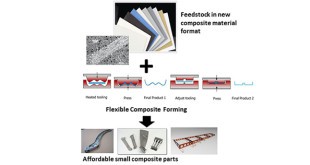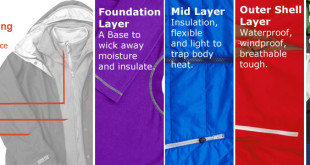The phonon is the physical particle representing mechanical vibration and is responsible for the transmission of everyday sound and heat. Understanding and controlling the phononic properties of materials provides opportunities to thermally insulate buildings, reduce environmental noise, transform waste heat into electricity and develop earthquake protection. The concept of …
Read More »Superhydrophobic and Omniphobic materials for self-cleaning soldiers clothes and reduce fuel costs of Ships and Submarines
Normal solid surfaces are wetted by liquids such as water and oil. In many cases, surface wetting is undesirable due to the fact that the liquids may largely deteriorate the functionality of the surface, or cause unwanted effects. For example, evaporation of liquid droplets could leave behind chemical or dirt …
Read More »DARPA Seeks New Composite Material and Process for Manufacturing Small Parts
After nearly a century of dominance as the material of choice for aircraft, metals are seeing increased competition from composite materials in use on Aircrafts. In the modern age, the aerospace industry is also looking ahead to tougher, lighter, and more heat-resistant materials that would lessen emissions, cut fuel costs, …
Read More »Military developing technologies like new clothing materials to survive in Extreme cold weather like Arctic
Norwegian oil and gas industry is heading into the Arctic, and its looking for Work clothing specifically tailored to Arctic conditions is hard to find. Industrial designers have now joined forces with researchers to create the perfect clothing concept. Wenaas is a leading supplier of work clothing to the oil …
Read More »Neuro- or Biohybrid systems to synthesize fuels, and chemicals and act as sensors for military
Neuro- or Biohybrid systems are systems formed by at least one biological component – i.e. already existing in living systems – and at least one artificial – newly engineered – component. Biological and artificial components are not independent but are passing information either in one or both directions, thereby forming …
Read More »Composite metal foam (CMF) for armor protection against larger caliber bullets, Radiation shielding and Fire safety
A metal foam is a cellular structure consisting of a solid metal (frequently aluminium) with gas-filled pores comprising a large portion of the volume. The pores can be sealed (closed-cell foam) or interconnected (open-cell foam). The defining characteristic of metal foams is a high porosity: typically only 5–25% of the …
Read More »Spintronic Magnetic Sensors have unique adavantages in current sensing, vehicle detection, bio detection for IoT and radar detectors for military
In quantum mechanics, spin is an intrinsic form of angular momentum carried by elementary particles. Spintronics is “A branch of physics concerned with the storage and transfer of information by means of electron spins in addition to electron charge as in conventional electronics.” Spin-based electronics focuses on devices whose functionality …
Read More »Researchers employing Simulation and Integrated Computational Materials Engineering (ICME) to accelerate the development of new materials
Finding new materials has traditionally been guided by intuition and trial and error,” said Turab Lookman, a physicist and materials scientist in the Physics of Condensed Matter and Complex Systems group at Los Alamos National Laboratory. “But with increasing chemical complexity, the combination possibilities become too large for trial-and-error approaches …
Read More »Auxetics, new materials for lightweight body and vehicle armor that strengthen when a bullet strikes
What do a flea and an eagle have in common? They can store energy in their feet without having to continuously contract their muscles to then jump high or hold on to prey. Now scientists Now scientists at Queen Mary University of London and University of Cambridge have created materials that …
Read More »German scientists are using drones equipped with sensors to locate metals needed for wind turbines and solar panels
The sustainable growth of renewable energies depends on the availability of key materials, for example Lithium is the key limiting resource for most batteries – while rare earth metals, in particular “lanthanides” such as neodymium, are required for the magnets in wind turbine generators. Copper is the conductor of choice …
Read More » International Defense Security & Technology Your trusted Source for News, Research and Analysis
International Defense Security & Technology Your trusted Source for News, Research and Analysis









